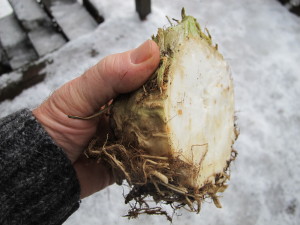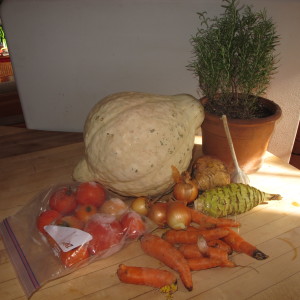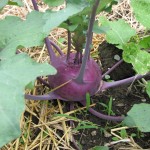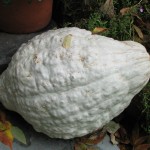Groundhog (Day) Soup
The old timers say that on Ground Hog Day we should still have half our wood supply – or more. This year I had more than half as it’s been a warm winter. Or perhaps not a real winter at all. At the half way point I always want to still have plenty of vegetables left from the summer, and I do. To celebrate Ground Hog Day this year I made a soup of my own vegetables, largely with root crops stored in the basement in an old fridge. Here is what I used:
Ground Hog Soup
1 rutabaga, cut in ½ inch cubes
1 kohlrabi, cut in ½ inch cubes
5 carrots, cut in rounds
3 medium-small yellow onions, finely chopped
½ a small celeriac, finely chopped
1 huge garlic clove, finely chopped
5 frozen whole large tomatoes (or substitute a 28 oz can crushed tomatoes)
2 cups winter squash, steamed
2-3 tablespoons finely chopped fresh ginger
1 tsp dried parsley
¼ to ½ tsp dried hot pepper (optional)
fresh rosemary (3-4 sprigs)
1 qt vegetable stock
1 cup cider
olive oil, salt and pepper as needed
To make the soup I began by sautéing the onions in olive oil until translucent. I use a heavy enameled iron pot for this. While the onions were cooking I chopped the rutabaga and kohlrabi into half-inch cubes, and the carrots into rounds. I added a quart of vegetable stock (I could have made my own, but cheated and used store-bought). Then I put in the root crops I’d cut up and turned down the heat to simmer. I added a cup of cider made from my own apples that I’d frozen, then thawed for this.
I’m sorry to admit that my supply of whole frozen tomatoes is getting low and will have to revert to store-bought canned tomatoes before the new crop comes in this summer. I freeze whole tomatoes in zipper bags in September because it is such an easy way to put them up, much easier than canning. Now I just run them under hot tap water and rub off the skins. I let them sit for a few minutes, then chop them up and toss into the pot.
I added some Espelette hot pepper powder – my own that I dried and ground in the coffee grinder – but you can add jalapeno and use more or leave it out altogether. I added dried parsley and fresh garlic, rosemary and ginger at this time, too.
I always have plenty of winter squash. This year I grew 2 large Hubbard squash in addition to many smaller Waltham butternut squash. For this soup I cracked open a Hubbard even though I couldn’t use all the meat from this 10-pound squash all at once. I cut it into many pieces, removed the seeds, and steamed it in a stock pot until it was soft.
I separated the flesh of the squash from the leathery skin with a large spoon and used 2 cups of the meat for this soup. The rest I cooled, then bagged and froze for later. I blended the squash in my food processor with liquid and tomatoes chunks from the soup pot, though you could use chunks of squash in the soup instead. I find pureeing it makes for a nice thick soup.
Last summer I dug my rosemary in mid-September and potted it in a 50-50 mix of potting soil and good compost. I’ve had it in a south-facing window and it has some soft growth as it leans toward the window, but is healthy, overall. I will start increasing the water to it as spring gets nearer. By March it will need twice as much water as I give it now. Three sprigs of this added good flavor to my soup.
A few words about rutabagas and kohlrabi. They are both great “keepers” for winter storage. Rutabaga grows well in full sun and rich, lightly moist soil. They need to be thinned to 8 inches apart early on or else you’ll get big tops and small roots. The flesh is sweet, not bitter the way some turnips can be. It works like potatoes in a soup, but never crumbles apart the way potatoes do.
Kohlrabi comes in purple or white varieties, and both are crispy and fresh either in a salad, soup or stir fry. ‘Kossak’ is a white variety that can be left in the ground all summer, getting huge – 8 inches or more – but not tough. It is designed for winter storage, and I usually grow some. Thin to 6 to 8 inches apart for good production, more if you are growing Kossak.
If you don’t have rutabagas or kohlrabi, you can substitute potatoes and perhaps add something else from your garden. I generally boil potatoes separately when adding to a soup or stew, and add them towards the end so that they are not mushy or crumbly. I bet green beans would be good in this soup, too. Whatever you use, it’s bound to be good. Bon appetit!
Henry gardens and cooks in Cornish Flat, NH. His e-mail is henry.homeyer@comcast.net. Or write him at P.O. Box 364, Cornish Flat, NH 03746. Please include a stamped envelope if you want him to answer a question.
Eating from the Garden – Now!
Before we launch into this week’s article…
Gardening Classes with Henry
Lebanon College: Gardening: A Practical Workshop. Garden writer Henry Homeyer will teach you the basics of organic vegetable and flower gardening. From garden design to seed-starting , planting, watering, weeding, mulching, and harvesting, this course will give each student practical knowledge of gardening. Tuesday nights from 6:30-8:30 for 5 weeks, April 3-May 2.Contact Lebanon College to reserve a spot for this5-part workshop www.lebanoncollege.edu or call 603-448-2445.
AVA Gallery, Lebanon. Henry will teach 3 classes at AVA Gallery this spring. You may sign up for one or all of these workshops:
Sculpting the Living Landscape: Starting Flowers from Seed
April 9; Monday, 6:30–8:30pm; One 2-hour class
Sculpting the Living Landscape: Perfect Perennials for the Upper Valley Garden
April 23; Monday, 6:30–8:30pm; One 2-hour class
Sculpting the Living Landscape: Organic Techniques for Enriching Soil and Managing Pests
May 7; Monday, 6:30–8:30pm; One 2-hour class
For more information go to www.avagallery.org or call 603-448-3117.
___________________________________________________________________________
I made a nice omelet for breakfast Sunday morning that had (in addition to the regulars of eggs, cheese and onion) parsnips and kohlrabi saved from my garden. The kohlrabi gave crunch, but not much flavor. The parsnips, however, were fabulous. They added zing – real garden flavor in January. I could have used carrots, beets, potatoes, celeriac or rutabagas, all of which I still have from my garden. I really like growing much of my own food – and saving it for use all winter is something I’ve worked hard on. It’s easy, and if you are studying those seed catalogs now, you might think about the veggies you can store well for winter eating.
Root crops like those mentioned above store well at 35-50 degrees, with high humidity – and a low rodent population. That’s right, mice and squirrels like root crops, so storing those veggies requires that you have a system. In past years I’ve stored root crops in 5-gallon pails in a cement-block “cold cellar” with an insulated plywood lid. The cold cellar was installed in a cold part of my basement and it kept my huge potato crop nicely. But mice can slip through the tiniest sliver of space, and sometimes did. So this year I’m trying something new.
Through the town list serve I obtained a free refrigerator, which I installed in my basement. It’s not new, but serviceable. I’m storing my root crops in it, and it is doing a fine job. No rodents to worry about, and it keeps the crops at a steady 35 degrees. Its only imperfection is that fridges are designed to maintain a lower humidity than my vegetables prefer.
Only the 2 vegetable drawers allow me to maintain high humidity, so for the rest I use plastic bins of veggies covered with moist towels. I also have a jute-lined wire bin that I use for carrots and parsnips. I layered them
with moist sand last fall, which keeps the humidity right (available from Gardeners Supply www.gardeners.com). Of all my root crops, rutabagas seem to require the highest humidity, so I place those in the drawers of the fridge.
But not all veggies like cool, moist storage. Winter squash like low humidity and a temperature of about 50 degrees. I don’t have the perfect place for them, but if you have an unheated guest bedroom, that’s perfect. Onions and garlic like the same type of environment. Last year I stored a blue Hubbard squash for more than 12 months! It grows a leather-like skin which protects the interior nicely, and when I finally cracked it open around Thanksgiving the flesh was perfect!
Some years I find my Waltham butternut squashes store for 6 months or more without problems, and then some years they tend to rot. I imagine it has to do with the moisture level at harvest time. I’ve read that washing winter squash before storage and then dipping them in a 10% Clorox solution will minimize fungal rot, and I have done it, but cannot swear that it makes much of a difference.
The freezer is always great for storing veggies, so I am currently using 2 full-size freezers in the basement, and the big freezer section in my kitchen fridge. Each summer I fill gallon bags with whole tomatoes that I freeze for winter use in soups and stews. I suck out the air from the bag with a straw, which minimizes frost on the fruit – it’s almost as good as using one of those machines sold for the purpose, but much cheaper. I just zip the bag shut (up to the straw) and once the bag is clinging to the fruit, I slide out the straw and close the bag shut.
Here’s a list of what I am still eating from my garden, in addition to the veggies mentioned above: frozen broccoli, kale, Brussels sprouts, leeks, peppers, beans, zucchini, winter squash, parsley, pesto, corn and peaches bought for winter use, raspberries, black berries, blueberries, plums, elderberries and apples and cider. I have tomato sauce in jars and in the freezer, along with tomato paste in the freezer. Then I have dehydrated Sungold cherry tomatoes, apples, blueberries, hot peppers on the shelf of the pantry or in the fridge. And of course I have lots and lots of garlic (stored whole in a cool, dry location), and a variety of winter squashes including butternut, buttercup and delicata.
But back to that blue Hubbard squash: There is something inherently daunting about a 20 pound squash. First there is cracking it open (I use a meat cleaver, but a saw or a wood splitter would work, too, I suppose).
Then there is the question of what to do with all that squash – when I finally did process it, it yielded 25 cups of pure food.
I placed big chunks of squash in my 16-quart stock pot with an inch of water and steamed it. When the flesh was soft I scooped it out and used some for a soup and froze the rest in zipper bags for later soups. My favorite soup using winter squash (based on one I ate while a Peace Corps volunteer in West Africa) also has peanut butter, hot peppers, fresh ginger, cumin and frozen tomatoes or tomato paste. I sometimes add black beans or kale for variety. It’s a good hearty winter soup that warms the body and soul. It’s great to be eating out of the garden in January. For the complete recipe, and one for roasted spicy squash seeds, go to my web site, www.Gardening-Guy.com. Bon appétit.
Henry Homeyer is the author of 4 gardening books. Contact him at P.O. Box 364, Cornish Flat, NH 03746 or by e-mail at henry.homeyer@comcast.net
Henry’s African Squash and Peanut Soup
This is my interpretation of a soup served throughout West Africa that I learned to love while living in Cameroon and Mali. You can vary the proportions according to your taste – a lot of hot pepper or a little; a lot of peanut butter or not so much. Improvising is good: I have been known to add kale or even fresh cranberries to it. Bon Appétit!
8 cups steamed winter squash, preferably Hubbard, but use what you have.
8 cups water
2 onions 2-4 cloves of garlic 4 fresh jalapeno peppers, chopped, or 1 tsp ground dry jalapeno
(add peppers in small portions until you decide how much you like)
2 stalks celery or half a large celeriac (which I use, because I grow it), chopped
6oz tomato paste
½ cup peanut butter
3 tablespoons grated fresh ginger
¼ teaspoon cinnamon
¼ teaspoon cardamom
½ teaspoon cumin
2-3 sprigs fresh rosemary, or 1 teaspoon Herbes de Provence or dry rosemary
2-3 bay leaves
2 Tablespoons honey (optional)
Salt and pepper to taste
Cooking Directions: Blend the cooked squash with water in food processor, add to a large heavy kettle in which you have sautéd the onions, garlic and celery. Add the other ingredients and let simmer for an hour or two. If you wish you can stretch the soup by adding more water.
Spicy Squash or Pumpkin Seeds
Remove and clean the seeds from a large winter squash or pumpkin and allow to dry for a day or more on a plate. Oil a large cast iron frying pad and add seeds. Keep heat at medium.
Stir in chili powder or hot pepper powder according to your taste. A pinch of cumin can add zing.
Add salt to taste.
Roast until the seeds are dark brown, stirring regularly to avoid burning.







